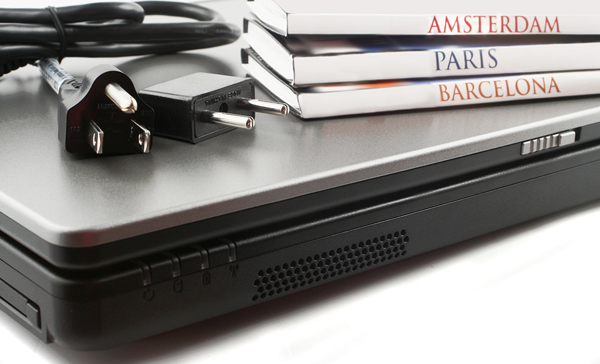Bringing Your Current Appliances and Electronics With You When You Retire to a New Country
By Mike Bieber
Summary: If you're moving or retiring abroad, which appliances should you take? Which should you leave behind? What type of voltage converters should you buy? Mike Bieber answers these and other questions.

If you're reading this, you've likely committed to the idea of becoming an expatriate. That's great news! Perhaps you making a fresh start and a fresh life in a new country. Or maybe it's a corporate- or military-sponsored relocation. Either way, at some point you'll encounter the arguably fun task of deciding what to take with you.
Everybody's circumstances are different; some only require a trunk full of clothes, a computer loaded with music and movies, a few books, and not much else. Families obviously require much more. And those pulling up the stakes for good will perhaps be bringing all of their worldly possessions including cars…and the dog. In fact, it's common for expats to move with appliances, electrical and electronic belongings, and furniture, particularly if they plan on living overseas indefinitely or permanently.
If you're in the latter category, a quality international moving company will make the arrangements for your belongings to make it to the other side via shipping container. However, an often overlooked fact for expats is international voltage differences and electricity. There are four voltage standards used throughout the world: 110-120 volts, the standard used in the US, Canada, Taiwan, and many Caribbean, Central American, and South American countries; 220-240 volts, which is the standard in Europe, Asia, Africa, and actually two-thirds of the world's nations; 127 volts, used primarily in Mexico and parts of Brazil; and 100 volts, which is used in Japan and only Japan.
The variation in international voltage standards means you cannot simply plug an appliance designed to work using 120-volt electricity in a wall outlet in a country that has 230 volts as its electricity standard. Doing so will render said appliance as toast: i.e., destroyed. Moreover, it can result in an electrical fire or a severe, potentially lethal shock. Conversely, plug an appliance or electronic device with needing 220-240-volt AC into a 110-120-volt outlet, and it'll barely work. Meanwhile, it's important to mention that plug adapters, which allow compatibility between the different plug shapes (there are approximately 15) used throughout the world, absolutely do not change international voltages. Keep this in mind.
So, what's the work-around for using appliances and electrical/electronic devices requiring 220-240-volt electricity in a country such as Japan, where the electricity standard is 100 volts? What about using the vintage McIntosh stereo amplifier that you inherited from your uncle, and that needs 117 volts of electricity, in Spain where the AC standard is 230 volts? Relocation consultants often mention three possibilities:
- You can buy entirely new appliances that are compatible with the voltage used in your new country here in the US or Canada (or whatever your native country might be) and have them shipped to your new country. If you ship directly to the shipping container you likely won't be charged sales tax, but customs and duties charges are a possibility.
- Buy appliances/electronics overseas in your new country, but recognize that they may not be the same size as an American or Canadian appliance. (Appliances are smaller in overseas countries.) Appliances and electronics will also be more expensive overseas for various reasons including currency fluctuations.
- Use a voltage transformer. These devices convert voltages by stepping up or stepping down incoming voltage to meet the power requirements of the appliance or electrical/electronic device. For example, a step down transformer converts 220-240-volt line voltage to 110-120 volts, or 127 volts to 100 volts. A step up model might convert 110-120 volts to 127 volts.
If you've decided to bring your appliances, electronics, and electrical devices from your home country to your expat country where the voltage standard is different, a well-made, high-quality voltage transformer will be the answer to your prayers. Why are we mentioning "well-made" and "high-quality"? It's because many (if not most) voltage transformers that you'll find when you search Google for "voltage transformers," are not well-made or high-quality. Actually, they're poorly made in China using cheap parts, unskilled labor, and packaged in similar black boxes stamped with an assortment of brand names such as Goldsource, Power Bright, Rockstone, and what seems like a dozen others. In fact, most come from the very same factory regardless of brand name.
Dig deeper and you'll notice a variation in price and build quality; some models seem flimsy while others appear more solid than an army tank. Some, in their product descriptions, barely mention a warranty and customer support yet others emphasize this point. Yes, there's a vast assortment of poor- and (less common) high-quality voltage transformers and, in the end, you get what you pay for. But the important consideration is not saving a buck but, rather, being safe and protecting the items that you've hauled across the ocean to your new home—including people. And, cheap voltage transformers are not safe.
Type in the words "voltage transformers" in Amazon's search field and the first product to appear is a black-box model sold under the Goldsource brand name. It's manufactured in China, priced at $32.95 (USD) and has a stated wattage capacity of 500 watts/volt amps and converts electricity from 110-120 volts to 220-240 volts, and vice-versa. This should mean that any electrical or electronic device that consumes 500 watts/VA or under should work fine. Then there's a model that's manufactured in the US; it, too, can handle wattage loads up to 500 watts/volt amps while converting electricity from 110-120 volts to 220-240 volts, and vice-versa. This model is priced at $159.99 (USD).
The significant price difference between these two transformers comes down to one primary determinant: the quality of the parts and manufacturing. The inexpensive, Chinese-made transformer is priced low because it uses cheap components that cause overheating and complete breakdown well before the transformer reaches its stated wattage. As you would figure, the more expensive, solidly-made American transformer is priced higher because it uses the safe components and along with safety features. These models are typically hand-assembled and tested at and beyond their stated wattage before leaving the factory.
Here's what's going on: transformers rely on basic electro-magnetic principles to work. Parts-wise, it's very basic; raw wire containing the electricity from the wall outlet is coiled around an iron or steel core to create a magnetic field. The incoming electricity (the primary current) is sent through the core to another coil (the secondary current) that—depending on how much wire coil is used—either increases or decreases the primary current's voltage. Cheap transformers cut corners by using inexpensive aluminum for the primary and secondary coils, and untreated iron for the core; these materials yield poor electrical conductivity and a very hard-working transformer, especially when it's delivering at or near maximum wattage ability. In the end, these models are hum loudly and reach very high temperatures.
The more expensive transformer uses pure copper for the primary and secondary coils. (FYI, copper is one of the most electrically conductive metals, second only to sterling silver.) This transformer also uses high-quality, silicon-coated electrical steel for the cores. The latter provides electrical resistance that, in basic terms, keeps the electrical current from running wildly and creating wasted electricity, plenty of heat, and an annoyingly audible hum.
Furthermore, nearly all Chinese-made voltage transformers rely on a glass cartridge fuse to work as a circuit breaker in the event of a voltage spikes and excessive wattage. (Both will severely damage your appliance). Normally, when an overload situation presents itself, the fuse will block the current and not allow it to reach said appliance. Hence, the fuse will "takes the hit" and consequently blow as it's designed to do. When the overload situation is corrected, you simply replace the fuse and you're good to go. That's why most budget transformers come with several replacement fuses.
Meanwhile, because the cheaper transformers are made with components that don't conduct electricity well, they have a tendency to catch on fire even without reaching the maximum stated wattage. Many reviews on Amazon confirm this. Tellingly, the Amazon product description for the aforementioned Goldsource 500-watt transformer advises that one purchase a model that states a wattage capacity that's two or three times the wattage you need as a "just in case" measure. Thus, if you're appliance requires 500 watts of electricity, buy a 1000-watt or 1500-watt model. Really?
One higher-priced, American-made transformer (manufactured by ACUPWR) uses a proprietary thermal protection circuit for as the circuit breaker. Infinitely safer than a cartridge fuse, this technology detects excessive heat caused by over-voltage or over-wattage and consequently turns the transformer off automatically. When the transformer cools down to its normal operating temperature, it automatically returns to operation. These transformers are the safest available and will never catch on fire or explode. And rather than breaking down when the current approaches the stated wattage, transformers using thermal protection circuitry can handle wattages that exceed the stated wattage, sometimes working up to 50-percent over. That's quite a safety net.
On another note, expats who are bringing refrigerators, freezers, washers and dryers overseas also need to be aware of the differences in AC frequency. Nearly all countries using the 220-240-volt standard use AC (alternating current) that travels at the rate of 50 Hz (or cycles per second). Other voltage standards, particularly 110-120, use 60 Hz AC. AC frequency differences aren't generally an issue except with those appliances that use high-power motors (such as those stated above). Unless these high-power appliances are used with electricity rated at the AC frequency as stated, their motors will crank at the incorrect RPMs and potentially burn out. Fortunately, there are very high- voltage transformers designed to be used specifically with high-motor appliances and, consequently, make an adjustment for frequency differences. So feel free to lug that ginormous 35 cubic-foot Jenn-Air 'fridge across the sea.
Is this everything there is to say about voltage transformers and the logistics of international voltage (and AC frequency) differences? Probably not—at least not without getting overly technical. Nonetheless, we're dealing the type of product that can either be a Godsend or (with the case of cheaply made models) a disaster; it simply depends of whether you as a consumer chooses affordability and corner-cutting over safety and reliability. Keep in mind that it works out financially if you spend a bit more and purchase the high-quality, American-made transformer over one manufactured cheaply in China. The latter will need to be replaced within a year or so, which the former will keep on keeping on, indefinitely.
About the Author
Mike Bieber is the Marketing Director for ACUPWR American-made voltage transformers. He is not related to Justin.
First Published: Sep 20, 2016


